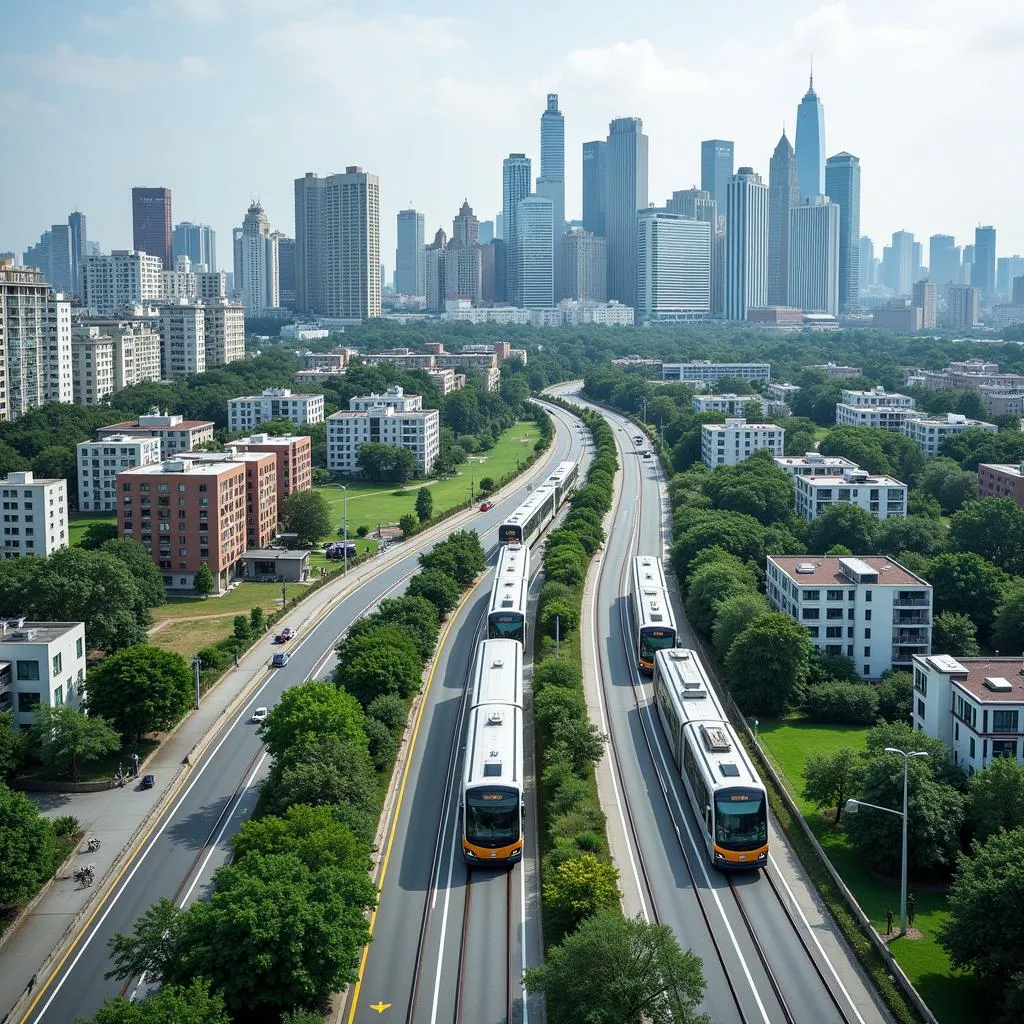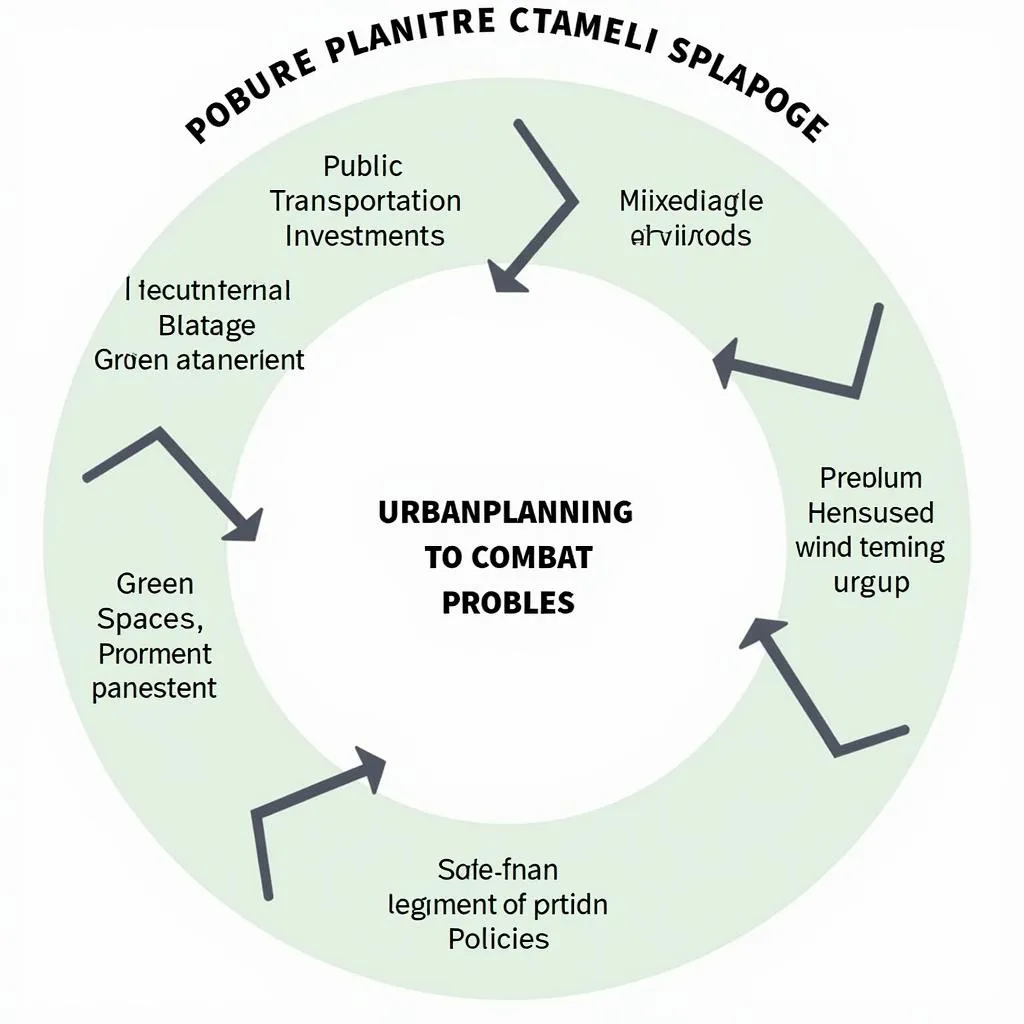Urban sprawl has become a pressing issue in many rapidly developing countries, and the role of government in managing this phenomenon is a topic that frequently appears in IELTS Writing Task 2. Based on recent trends, we can expect this theme to continue being relevant in future exams. Let’s examine a typical question on this subject and analyze how to craft effective responses across different band scores.
Some people believe that governments should invest heavily in public transportation to reduce urban sprawl and traffic congestion. Others argue that such investments are ineffective and that other solutions are needed. Discuss both views and give your own opinion.
Analyzing the Question
This question presents a classic IELTS Task 2 structure, asking candidates to discuss two contrasting viewpoints and provide their own opinion. The topic focuses on the role of government in addressing urban sprawl and traffic congestion through public transportation investments. Key points to consider include:
- The belief that government investment in public transport can reduce urban sprawl and congestion
- The opposing view that such investments are ineffective
- Alternative solutions to the problem
- Your personal stance on the issue
Now, let’s examine sample essays for different band scores, starting with a high-scoring response.
Sample Essay 1 (Band 8-9)
Urban sprawl and traffic congestion are significant challenges facing many cities worldwide. While some advocate for substantial government investment in public transportation as a solution, others contend that this approach is ineffective and alternative measures are necessary. In my opinion, while public transportation is a crucial component, a multi-faceted strategy is required to address these complex issues effectively.
Proponents of government investment in public transportation argue that it can significantly reduce urban sprawl and traffic congestion. By providing efficient and affordable alternatives to private vehicles, such as buses, trains, and metro systems, cities can encourage residents to live in more densely populated areas near transit hubs. This concentration of population can limit the outward expansion of urban areas and reduce the number of cars on the road, thereby alleviating traffic congestion. Moreover, well-planned public transportation networks can improve accessibility to jobs and services, reducing the need for long commutes and urban sprawl.
However, critics argue that investing heavily in public transportation alone is insufficient to solve these problems. They contend that other factors, such as zoning laws, housing policies, and economic incentives, play equally important roles in shaping urban development patterns. Furthermore, they point out that in some cases, improved public transportation can actually encourage urban sprawl by making it easier for people to live further from city centers while still commuting to work. These skeptics advocate for a more comprehensive approach that addresses the root causes of urban sprawl and traffic congestion.
In my view, while government investment in public transportation is essential, it should be part of a broader strategy to manage urban growth and mobility. Effective solutions should integrate transportation planning with land use policies, promoting transit-oriented development and mixed-use neighborhoods. How can governments address the challenges of urban sprawl? This could include incentives for high-density housing near transit hubs, implementing congestion pricing in city centers, and improving bicycle and pedestrian infrastructure. Additionally, governments should explore innovative technologies, such as smart traffic management systems and ride-sharing platforms, to complement traditional public transportation options.
In conclusion, while investing in public transportation is a crucial step in managing urban sprawl and traffic congestion, it is not a panacea. A holistic approach that combines transportation improvements with smart urban planning and technological innovations is necessary to create sustainable, livable cities for the future.
 Government investment in public transportation to reduce urban sprawl
Government investment in public transportation to reduce urban sprawl
Essay Analysis (Band 8-9)
This essay demonstrates excellent command of the English language and addresses all aspects of the task effectively:
-
Task Achievement: The essay fully addresses the prompt, discussing both viewpoints and clearly stating the writer’s opinion. It provides well-developed arguments and relevant examples.
-
Coherence and Cohesion: The essay is well-organized with clear paragraphing and effective use of cohesive devices. Ideas flow logically, and each paragraph has a clear central topic.
-
Lexical Resource: The writer uses a wide range of vocabulary accurately and appropriately, including topic-specific terms like “transit-oriented development” and “congestion pricing.”
-
Grammatical Range and Accuracy: The essay displays a wide range of complex structures used accurately, with only minor errors that do not impede communication.
Sample Essay 2 (Band 6-7)
Urban sprawl and traffic congestion are big problems in many cities today. Some people think the government should spend a lot of money on public transportation to solve these issues, while others believe this is not effective and we need different solutions. I will discuss both sides and give my opinion.
Those who support government investment in public transportation say it can help reduce urban sprawl and traffic problems. If cities have good buses, trains, and subways, people might choose to live closer to the city center and use these services instead of driving cars. This could mean fewer cars on the roads and less traffic. Also, if public transportation is convenient, people might not need to move to the suburbs, which can help stop cities from spreading out too much.
On the other hand, some people think that spending money on public transportation is not enough to fix these problems. They say that other things, like where houses are built and how cities are planned, are also important. Sometimes, even if there is good public transportation, people still choose to live far from the city and drive their cars. These critics think we need to look at more than just transportation to solve urban sprawl and traffic issues.
Impact of urbanization on social services is another important factor to consider when discussing urban development. As cities grow and spread, it becomes more challenging to provide efficient social services to all areas.
In my opinion, I think both sides have good points. While public transportation is important, I believe we need a combination of solutions to really solve these problems. Governments should invest in good public transportation, but they should also think about how cities are designed and use new technologies to help manage traffic. For example, they could encourage people to live near train stations by building more apartments in these areas, or use smart traffic lights to help cars move more smoothly.
In conclusion, investing in public transportation is helpful, but it’s not the only answer to urban sprawl and traffic congestion. We need to use different strategies together to create better cities for everyone.
 Comprehensive urban planning strategies to combat sprawl
Comprehensive urban planning strategies to combat sprawl
Essay Analysis (Band 6-7)
This essay demonstrates a good command of English and addresses the task adequately:
-
Task Achievement: The essay covers both viewpoints and provides a personal opinion. However, the ideas could be more fully developed with more specific examples.
-
Coherence and Cohesion: The essay has a clear structure with introduction, body paragraphs, and conclusion. Cohesive devices are used, but sometimes in a repetitive manner (e.g., frequent use of “also” and “on the other hand”).
-
Lexical Resource: The vocabulary used is adequate for the task, with some attempt at using less common words. However, there is some repetition and the range could be wider.
-
Grammatical Range and Accuracy: The essay uses a mix of simple and complex sentence structures with generally good control. There are some minor errors, but they do not impede communication.
Key Vocabulary to Remember
-
Urban sprawl (noun) – /ˈɜːrbən sprɔːl/ – The uncontrolled expansion of urban areas into surrounding rural land.
-
Traffic congestion (noun) – /ˈtræfɪk kənˈdʒestʃən/ – The condition of overcrowding on roads, causing slower speeds and longer trip times.
-
Public transportation (noun) – /ˈpʌblɪk ˌtrænspɔːrˈteɪʃn/ – Modes of transport available to the public, typically managed by government or private companies.
-
Transit-oriented development (noun) – /ˈtrænzɪt ˈɔːrientɪd dɪˈveləpmənt/ – A type of urban development that maximizes the amount of residential, business and leisure space within walking distance of public transport.
-
Congestion pricing (noun) – /kənˈdʒestʃən ˈpraɪsɪŋ/ – A system of surcharging users of public goods that are subject to congestion through excess demand.
-
Zoning laws (noun) – /ˈzoʊnɪŋ lɔːz/ – Regulations that govern how land in specific geographic zones can be used.
-
Mixed-use neighborhoods (noun) – /mɪkst juːs ˈneɪbərˌhʊdz/ – Urban areas that blend residential, commercial, cultural, institutional, or entertainment uses into one space.
-
Sustainable (adjective) – /səˈsteɪnəbl/ – Able to be maintained at a certain rate or level without depleting natural resources or causing severe ecological damage.
-
Holistic approach (noun) – /hoʊˈlɪstɪk əˈproʊtʃ/ – A strategy that takes into account all of the elements or complexities of a situation, rather than just a single aspect.
-
Smart traffic management systems (noun) – /smɑːrt ˈtræfɪk ˈmænɪdʒmənt ˈsɪstəmz/ – Advanced technologies used to monitor and control traffic flow to reduce congestion and improve efficiency.
Conclusion
The topic of government’s role in managing urban sprawl through public transportation investments is likely to remain relevant in IELTS Writing Task 2. To prepare effectively, practice writing essays that discuss multiple perspectives and provide well-reasoned opinions. Focus on developing a wide range of vocabulary related to urban planning, transportation, and government policies. How to address the challenges of urbanization is a crucial skill for IELTS candidates to master.
For further practice, consider writing essays on related topics such as:
- The impact of remote work on urban planning and transportation needs
- The role of technology in solving urban congestion problems
- Balancing economic growth with sustainable urban development
Remember to structure your essays clearly, use a variety of vocabulary and sentence structures, and support your arguments with relevant examples. Good luck with your IELTS preparation!
We encourage readers to practice writing their own essays on this topic and share them in the comments section below. This active engagement can significantly improve your writing skills and prepare you better for the IELTS exam.


